by Rod Hamilton
“My fish is in the mangroves, now what do I do?”
One of the great things about having a website and blog is the interaction I have daily with fisherman from around the world. Sharing ideas, learning about the occasional secret spot and passing on tips (always learned the hard way) makes it fun to be a participant in the industry.
A couple of recent questions from subscribers about how to land fish when they are in the “bushes” had me reflecting on my own trials and tribulations regarding this common DIY scenario;
Their confusion about what to do in that situation originated from the same place that it had for me. They had received conflicting instructions about how best to fight a fish once it was in the mangroves.
I wasn’t with them and each situation tends to be a little different, but I can assume the tactical fighting advice ranged from “put the boots to it” to “give it slack and let it run.”
Before I tell you what I do, let me set the stage and walk you down the path I took which eventually led to a substantial increase in landed fish.
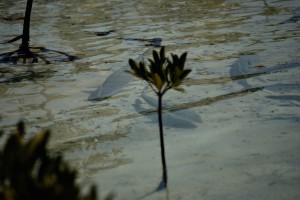 I started the same place we all did. On the front of a boat with a guide expertly poling me along, pointing out fish that I couldn’t see. But the reality was I seldom fished in tricky mangrove areas, its just not where guides take you. Mostly we were fishing flats in relatively open and benign areas.
I started the same place we all did. On the front of a boat with a guide expertly poling me along, pointing out fish that I couldn’t see. But the reality was I seldom fished in tricky mangrove areas, its just not where guides take you. Mostly we were fishing flats in relatively open and benign areas.
Occasionally the guide would pole along a mangrove edge and the fish would elect to panic, swimming at warp speed back into the mangroves, but usually it stayed where the battle did not include obstructions.
I describe this typical scenario to point out that I, like most boat guided anglers, didn’t have that much practice extracting fish from deep in the mangroves. So it’s no wonder we tighten up, get anxious and are not sure what to do.
But for a walk and wade DIY guy it is just the opposite. I fish along edges and deep inside creek systems probably as much as on open flats. I mean how many flats are there where I can walk, bike, drive or kayak too?
My partners and I do not fish where guides and others go so edges, creeks and the “middle of nowhere” are much more the rule than the exception.
Since the tough places make up at least 50% of the locations, it became obvious I needed to get much better at, stalking, casting and landing fish in the mangroves. These became mandatory skills not just one-offs.
My usual fishing buddy and I made the decision to figure out how to increase our “landed” ratio and win the jungle battle. If you ask us now what percentage of fish we land, we can comfortably say fifty percent. In fact, he just returned from North Andros, went into the sticks the last afternoon and ended up with four of six. Which seems about right.
After extracting out of the mangroves a few hundred fish between us, here are the three methods we use.
Yank and Crank
The title says it all, but let me explain. When I know I’m going deep into a creek system and am surrounded by roots and branches I make three significant equipment changes. I snip off my #12 tippet and tie on #20 pound. I tighten my drag to about as tight as it will go. And switch to a larger, flashier fly. What we have found is that deep within the protective cover of the mangroves the fish are not the least bit leader shy. No need for delicate presentations with small flies on light leaders. So I go with flies they can see, that make a splash when they hit and attach it to as strong a tippet as I have in the bag. Normally these are short pinpoint casts into tiny holes and pockets. When the fish hits, strip strike and then literally fight the fish right where you hooked it. It’s a hell of a battle, but you just don’t let it run. I’ve never landed a fish larger than 4 1/2 pounds doing this but then that takes into account 90% of all the fish you will see.
Walk the Dog
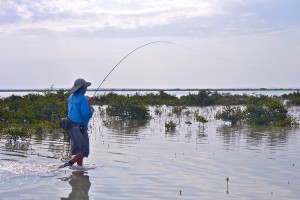 This one is crazy, it shouldn’t work and goes against all your instincts, but the results will surprise you. Use this where the fish has tucked itself into the mangroves but there is a distinct opening or channel out to clear flats where you want to fight the fish. Cast your fly as close to the opening (clear water) as possible but where the fish can see the fly or hear it “plop”. Hook the fish with a gentle strip strike but then apply no pressure, the goal is to make sure the fish is attached to the hook, but it doesn’t really know it’s hooked. When there is no line pressure on the fish they calm down very quickly. And here is the amazing part. With just the slightest tension you can literally guide the fish and “Walk The Dog” into open water. Once in the clear you apply pressure, the fish realizes it is hooked and the fight is on. I know you don’t believe me, but it works. Try this for yourself sometime on a single fish (doesn’t work as well if it’s in a school). Set the hook but apply no pressure, don’t lift the rod, don’t let it know it has been hooked. The fish will calm down very quickly.
This one is crazy, it shouldn’t work and goes against all your instincts, but the results will surprise you. Use this where the fish has tucked itself into the mangroves but there is a distinct opening or channel out to clear flats where you want to fight the fish. Cast your fly as close to the opening (clear water) as possible but where the fish can see the fly or hear it “plop”. Hook the fish with a gentle strip strike but then apply no pressure, the goal is to make sure the fish is attached to the hook, but it doesn’t really know it’s hooked. When there is no line pressure on the fish they calm down very quickly. And here is the amazing part. With just the slightest tension you can literally guide the fish and “Walk The Dog” into open water. Once in the clear you apply pressure, the fish realizes it is hooked and the fight is on. I know you don’t believe me, but it works. Try this for yourself sometime on a single fish (doesn’t work as well if it’s in a school). Set the hook but apply no pressure, don’t lift the rod, don’t let it know it has been hooked. The fish will calm down very quickly.
Be Free Butterfly
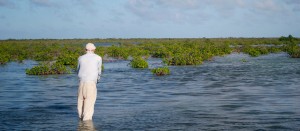 This is the tactic I use most often, works great and my success rate is easily 50%. I don’t use this technique when I am deep in the mangroves, rather when I am walking edges and there is a chance that if I hook a fish it will go left into trouble instead of right to the open water. This is all about preparation and knowing in advance what you are going to do. First, you must completely release the drag, virtually a free spool before you start fishing. It’s to late to do it after the fish is hooked. Then once your connected (remember this is right along a mangrove edge) you palm the reel, apply as much pressure as you can and do your best to horse the fish into the open. If that doesn’t work and it makes its way into or around roots, immediately go into free spool, pointing the rod tip at the fish. It is at this point the inexperienced angler looses the fish. They don’t understand what free spool means…….no pressure, get your freaking hand away from the reel, let it go, let the reel run free. All the pressure that is required to stop the fish is applied from the friction created by the fly line rubbing against the mangroves.
This is the tactic I use most often, works great and my success rate is easily 50%. I don’t use this technique when I am deep in the mangroves, rather when I am walking edges and there is a chance that if I hook a fish it will go left into trouble instead of right to the open water. This is all about preparation and knowing in advance what you are going to do. First, you must completely release the drag, virtually a free spool before you start fishing. It’s to late to do it after the fish is hooked. Then once your connected (remember this is right along a mangrove edge) you palm the reel, apply as much pressure as you can and do your best to horse the fish into the open. If that doesn’t work and it makes its way into or around roots, immediately go into free spool, pointing the rod tip at the fish. It is at this point the inexperienced angler looses the fish. They don’t understand what free spool means…….no pressure, get your freaking hand away from the reel, let it go, let the reel run free. All the pressure that is required to stop the fish is applied from the friction created by the fly line rubbing against the mangroves.
First one root, then another and so on. Eventually and gradually it slows the fish down until it can’t pull against the drag created by the fly line and roots. The fun begins at this point as the fisherman now has to thread the rod and reel through exactly the same place the fish swam. But in the end you walk up to a bonefish that you can hold and unhook.
Good luck, hope this gives you a little more confidence to go into the ugly areas and land some of those hard to catch fish.
Rod’s new book “Do It Yourself Bonefishing” is spectacular! You can read a review HERE.
Or order your copy HERE
Rod Hamilton Gink & Gasoline www.ginkandgasoline.com hookups@ginkandgasoline.com Sign Up For Our Weekly Newsletter!
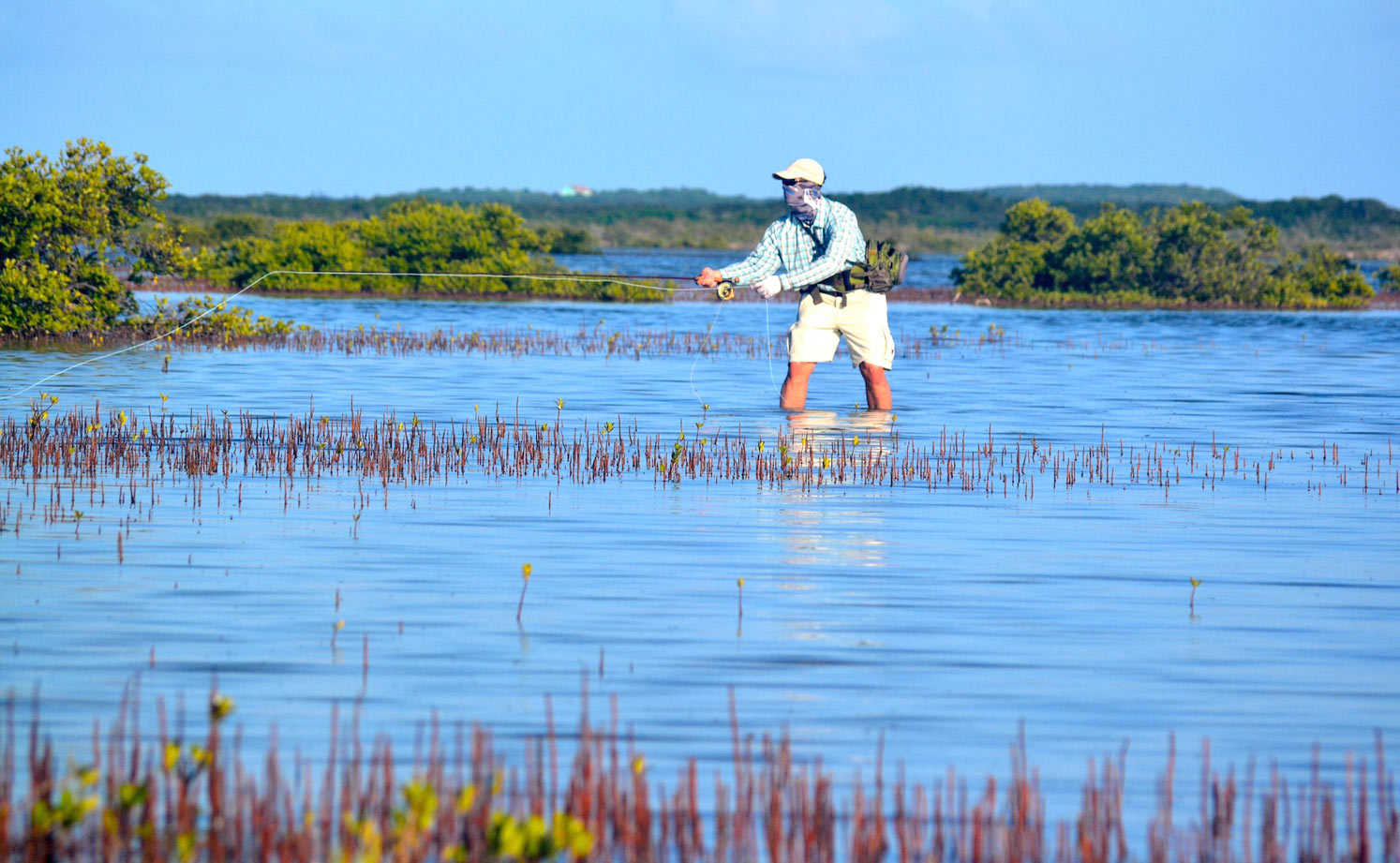
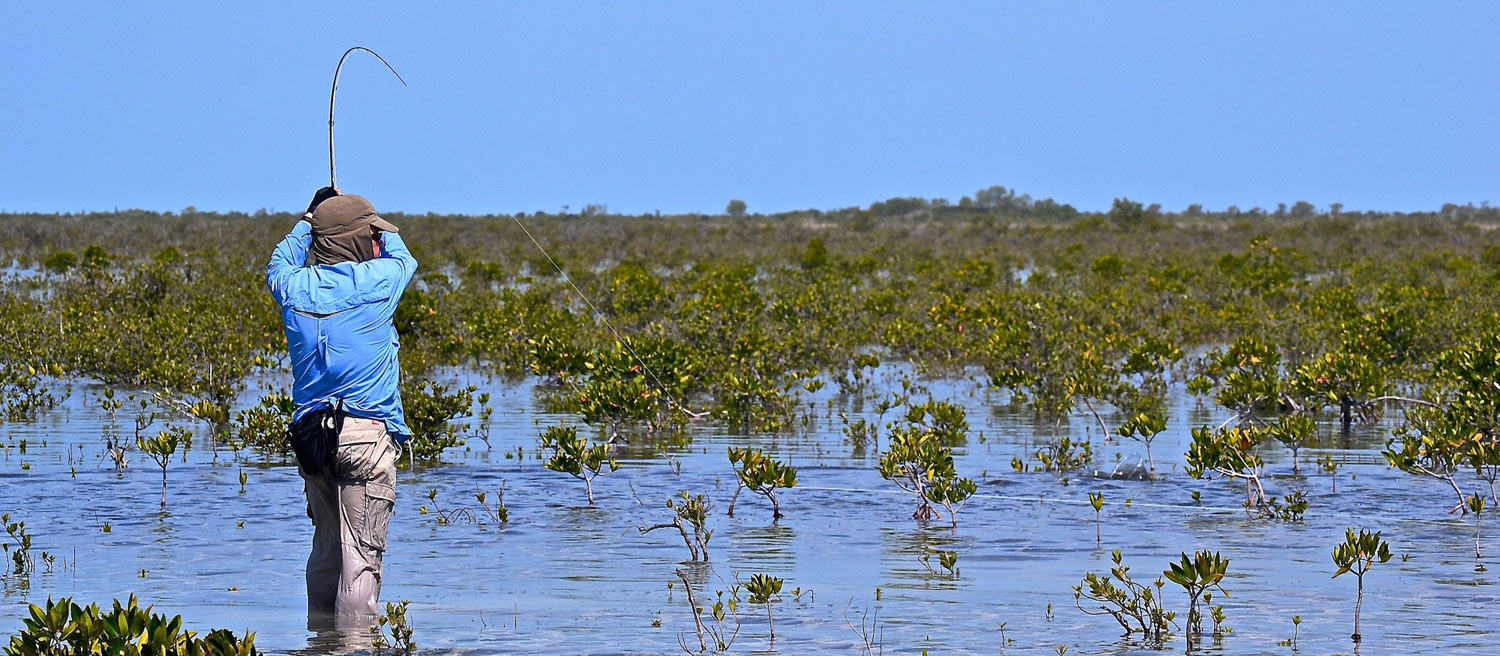
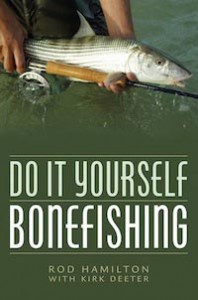
I’ve used ‘walk the dog’ on great lake steelhead. Some times it works. Sometimes you get you ass handed to you…
Are we talking about other species besides bonefish? How many different target species will you find near or in the mangroves? Do the different species often eat the same forage or flies?
Sometimes it’s just plain luck. Once, in Belize, there was a tarpon working at the end of a very narrow channel in the mangroves. I remember having to hold the rod over the top of head in order to cast absolutely straight ahead maybe 35 feet. The fish took, came right back up the channel toward the boat, turned around and went straight back down the channel to the end, turned left, and was gone. Maybe five or so seconds of fun, but still among my most remembered fish.
I tried your “free reel approach” on a permit once, and got a totally chewed up fly line back after about 15 minutes of the fish running through the mangroves. Some fish just win.
These are great tip’s. Get um on the reel, that is all I remember hearing. We went to Cat Island in July and read your reviews prior to our trip. We were guided for 3 days and ventured ourselves 3 days. It was perfect! Both my husband and I’s first time boning. The addiction is reel. We stayed at Fernandez Bay, as the Halverson House is no longer open.
We purchased Rod Hamilton’s book before our trip as well – super helpful. The locals on Cat are super friendly and would tell us right down to the details how to walk I to locations.
Fishes in the mangroves?
Grenades: Pull the pin, toss it in. 😉